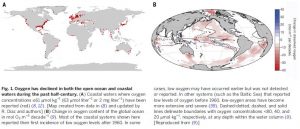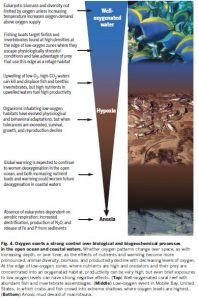Declining oxygen in the global ocean and coastal waters: A summary
By Abby Tinari, SRC intern
Oxygen is not only important for life on Earth, but it also regulates major nutrient and carbon cycles globally. All the past major extinction events have been associated with oxygen-deficient oceans and warm climates. Over the last 50 years, the anoxic (no oxygen) volume of the ocean has quadrupled, and hypoxic (low oxygen) zones have increased by the size of the European Union (Figure 1). In the summary below, Breitburg et al 2018 describe the causes (Global warming and nutrient enrichment), good and bad effects and responses (effects of ocean deoxygenation & biological responses and Biogeochemistry), current predictions and models (predicting oxygen decline), and some solutions that are available (reducing deoxygenation and its negative effects).

Figure 1 Breitburg et al 2018
Global warming
Warming waters reduce oxygens ability to dissolve into water. This decrease in solubility contributes ~15% of the total oxygen loss. Metabolic rates also influence the total oxygen loss. Higher metabolic rates, which are caused by warmer temperatures, require organisms to consume more oxygen, leading to higher CO2 production, and more acidic waters. More acidic waters harms and decreases organism’s ability to efficiently use dissolved oxygen. The other 85% of total oxygen loss comes from the reduction of ventilation, the transport of oxygen into the interior of the ocean, and the supply of nutrients that control organic matter production. The low oxygen predicted with global warming may have a human benefit for a time, winds are expected to be strengthened and in turn increase upwelling along coasts. The increase in upwelling may see an increase in commercially popular marine organisms. But upwelling brings hypoxic water to the surface, adding to the deoxygenation problem. Just like in the open ocean, water stratification and a decrease oxygen solubility are expected to increase in coastal waters but at a faster rate.
Nutrient enrichment of coastal waters
Nutrient loads entering coastal waters have increased by 43% from 1970 to 2000 with the increase in human population and agricultural production. The excess nutrients (Nitrogen and Phosphorus) cause eutrophication. Eutrophication encourages algae growth and ultimately causes a decrease in oxygen through excess decomposition (which consumes oxygen). Low vertical exchange and long retention times further exacerbate the hypoxic conditions in coastal waters.
Effects of ocean deoxygenation & biological responses
Effects of low oxygen will occur in organisms in a variety of ways, as they have a wide range of oxygen tolerances. Life processes in aerobic organisms from genes to entire ecosystems depend on oxygen. Different exposures to low oxygen levels can reduce survival and slow growth, impair reproduction, induce genetic changes in future generations, and alter immune responses. Organisms that depend on oxygen gradients to migrate may be constrained, effecting not only those organisms, but also their predators. Alternatively, organisms that can tolerate hypoxic waters may better avoid predators and expand their ranges. Mobile organisms, such as fish and invertebrates are expected to shift poleward and to deeper waters with ocean warming.

Figure 2 Breitburg et al 2018
Biogeochemistry
Since many nutrient-cycling processes are dependent on oxygen, small changes in local low oxygen areas can influence productivity, nutrient (N, P, Fe and many others) budgets and trace metal distributions on global scales. Many of the by-products of low oxygen levels are toxic or greenhouse gases, i.e. hydrogen sulfide, nitrous oxide, cyanobacterial blooms etc.
Predicting oxygen decline
Reliable numerical models to predict different scenarios on the effects of climate change and eutrophication in waters around the world are the basis of marine ecosystem management. The models agree on the amount of oxygen lost by the end of the century (a few percent) which could have substantial effects on abiotic and biotic systems. But where the low oxygen zones will be located is under debate, limiting our ability to predict and create management plans for these areas. These complicated models need to predict a multitude of factors from human population growth rates to the timing and intensity of precipitation and warming and 3-D water movement and quality models to the effects of education and income on sanitation and animal protein use. All aspects of life need to be integrated into the models to predict the effects.

Figure 3 Breitburg et al 2018
Reducing deoxygenation and its negative effects
Efforts need to be made on local, national, and global scales to limit declines, restore, and support the resilience of ecosystems that have dealt with unusual levels of oxygen. Many of the solutions to deoxygenation can substantially benefit society, i.e. improved sanitation can reduce nutrient loads in waters and help increase human health. Some of the solutions will take time, i.e. oxygen demand from sediment can take decades to decrease, but other methods such as nutrient reduction in the Chesapeake Bay have already produced results not seen since 1984. To create an ecologically and economically effective plan, a combination of methods must be used and stakeholders from all parts of society (scientist, government, industry and the public) must be involved.
Works Cited
Breitburg, D., L. A. Levin, A. Oschlies, M. Grégoire, F. P. Chavez, D. J. Conley, V. Garçon, D. Gilbert, D. Gutiérrez and K. Isensee (2018). “Declining oxygen in the global ocean and coastal waters.” Science 359(6371): eaam7240.
